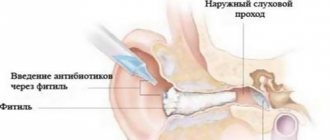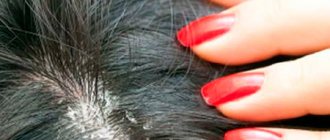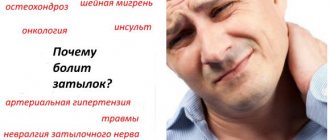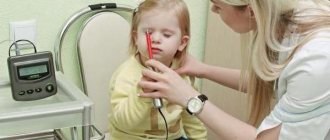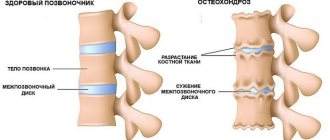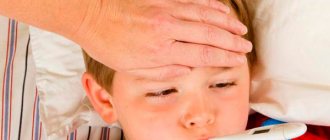What to do if you have a head injury and how to properly treat the injury
Every person knows from childhood that the head is one of the most important parts of the body . The brain is located inside the skull, so even minor damage can cause serious consequences. Most often, a head injury occurs as a result of a blow with a blunt object or a fall on the head.
Photo 1. After hitting your head, you need to carefully monitor your well-being. Source: Flickr (Malcolm Skinner)
Classification of injury
Head injuries are distinguished by the location of the damage, differentiated:
In the first case, the injury does not lead to serious consequences, in the second, as a rule, it is fraught with serious complications.
According to the degree of severity, they are distinguished:
- 1st degree . The skin is not significantly affected - there may be scratches and bumps. No special treatment methods are required; small abrasions go away on their own within 3-4 days.
- 2nd degree . A bruise causes tissue rupture. Swelling and hematomas appear. Acute pain appears at the site of injury.
- 3rd degree . The force of impact at this stage can lead not only to tissue rupture, but also to serious complications. The pain gradually increases.
- 4th degree . The last degree of injury is the most dangerous and is accompanied by changes that disrupt the normal functioning of organs, in particular the brain.
Bruises of the 1st-2nd degree do not pose a serious danger and pass quickly, although they cause discomfort, since they are difficult to hide from prying eyes; bruises of the head, especially the front part, i.e. the face, seriously spoil the appearance.
More severe bruises are manifested not only by external tissue damage, but lead to pathological changes in the brain.
Symptoms and signs
Symptoms depend on the severity of the injury and the extent of the injury. Most often, a regular bruise can be identified by the following signs:
- Pain in the impact area;
- A lump or swelling appears at the site of the injury ;
- There is limited collection of blood (bruising);
- Possible nosebleeds;
- There is a slight local and sometimes general increase in temperature;
- With more severe degrees of injury, confusion, weakness, and loss of consciousness may occur.
Note! It is very important to pay due attention to the injury, which results in nausea, loss of consciousness, vomiting, blurred vision and progressive pain. Such a reading is a signal of severe damage.
What is the difference between a head injury and a concussion?
A concussion, as a rule, occurs as a result of injury, including 3-4 degree bruises.
As a result of a concussion, a person experiences symptoms that are unusual for a mild bruise affecting only soft tissues:
- During the injury, mild fainting and loss of consciousness may occur,
- disorientation for a short period of time,
- in addition to the headache, severe dizziness occurs,
- there is tinnitus,
- There may be nausea and vomiting.
It is important! During a concussion, it is difficult to concentrate one’s gaze, there is inhibition of reactions and disorientation in space and time. The person is pale, weak and tired, healthy appetite and sleep disappear.
All these symptoms are not observed with milder degrees of injury; they occur only when the injury is accompanied by a concussion.
Head injury in children
If a child hits his forehead and a bump or bruise appears at the site of the impact, you need to apply ice or something cold . The frontal bone is quite hard, so in the absence of serious external signs and problems with well-being, the help of a doctor is not required. The swelling will go away on its own within a short period of time.
infants should be taken more seriously ; they should definitely shown to a pediatrician . For example, a child falling on the back of his head can have bad consequences.
It is better to show the child to a doctor; injury can cause hematomas in the brain, blurred vision, concussion, etc.
First aid for bruise
The first thing to do is to examine the injured person.
wounds or serious abrasions on the skin
If there are bruises, apply something cold for 20 minutes.
Let the victim lie in bed for several hours. Do not give any medications.
If you have serious symptoms listed above, you should call a doctor. In this case, place the person in the most comfortable position for him and ensure peace.
It is important! Do not let the victim fall asleep until the doctor arrives. Continue to monitor his condition. In case of loss of consciousness, carefully shift the victim to his side, bend his knees closer to his chest, and place his hands under his head.
Diagnostics
To diagnose a bruise, you will need a routine examination by a traumatologist and will need x-rays . With their help, the doctor will be able to rule out more serious skull injuries.
In case of complications, additional diagnostic methods will be required.
The traumatologist may refer you to a neurologist . A spinal tap is taken and a CT scan is performed.
Treatment
Treatment of a bruise can be either conservative or surgical, depending on the degree of injury and accompanying symptoms.
Note! Head injuries require immediate medical attention, even if they seem minor. Some patients may not show symptoms immediately after an impact, which indicates severe injury, but later lead to serious consequences.
Basics of hospital treatment
Surgical intervention is indicated only in 15% of cases. The services provided for the operation are:
- cerebral hematomas
- significant movement of brain structures or hypertension that cannot be treated with medication.
With the conservative method, treatment with medications is indicated.
- Diuretics are prescribed to help eliminate cerebral edema. Oxygen therapy is indicated.
- Sometimes tracheal intubation is performed (only if necessary).
- Blood pressure is regularly monitored using infusion therapy.
- Anticonvulsants are prescribed. Control ischemic changes with antihypoxants.
Home treatment rules
After suffering a severe injury, any physical activity is prohibited . In the first days, only bed rest and rest are indicated.
A couple of days after the injury, you need to go outside more and breathe fresh air .
Spending long periods of time at the computer and TV is prohibited.
Folk remedies
Before resorting to traditional medicine methods, it is better to consult a doctor. If there are serious consequences, folk remedies may be ineffective.
The following recipes are often used:
- Iodine and alcohol in equal proportions, apply a compress to the bruise;
- Place a cloth previously soaked in salt water Before applying to the affected area, moisten it a little with water so that the fabric melts slightly.
- honey, mustard powder and salt in equal parts . Apply the resulting mixture to the injured area and leave overnight.
Complications and consequences of injury
The consequences of a head contusion can be different, they depend on the severity of the injury. With a mild degree, all symptoms quickly pass without leaving a trace. Whereas, due to severe bruises, serious complications are possible, such as:
- Deterioration or loss of vision, hearing, smell;
- Abscesses in the brain;
- Loss of muscle control;
- Speech and memory disorders;
- Nervous disorders.
Photo 2. After a bruise, memory impairment may occur. Source: Flickr (Smartex).
It is customary to distinguish between primary complications that arise as a result of exposure to a traumatic factor:
- thrombosis,
- rupture of blood vessels,
- disruption of cell membrane permeability, which causes cell death,
- disruption of connections between nerve cells.
As a rule, with proper treatment, these disorders are eliminated and functionality is not lost.
Secondary damage occurs as a result of inflammation in the lesion. The success of treatment largely depends on timely treatment and the extent of the lesion.
In many ways, the consequences of a head injury depend on the age of the patient , for example, for older people, such injuries can bother them for quite a long time, and often lead to disability.
In some cases, a bruise received in childhood can make itself felt much later.
Lack of timely treatment can cause constant dizziness and frequent headaches, persistent intracranial hypertension.
Rehabilitation period
Rehabilitation measures for minor bruises are associated with the healing of damaged tissues and restoration of functions in case of more serious injuries.
Severe head contusions heal slowly, and in some cases can last for many years.
Physiotherapeutic procedures (UHF, electrophoresis) are used for rehabilitation
For the first week after severe bruises, it is recommended to adhere to bed rest and avoid stress: you cannot read or watch TV.
Source: https://glavtravma.ru/ushiby/golova-222
When is it necessary to consult a doctor?
In rare cases, self-treatment of a lump is prohibited.
If, in addition to a bump on your forehead, symptoms such as:
- inability to turn your head;
- nausea;
- vomit;
- enlarged pupils;
- blurred vision;
- severe pain in the forehead;
- retardation of movements;
- confusion;
- pale skin, blue lips;
- convulsions.
These signs indicate a concussion and require urgent medical advice.
If, in case of a bruise, you immediately provide first aid to the patient, then the next day there will be no trace of the bump.
- Carefully treat the impact site with hydrogen peroxide (or Chlogexidine, Miramistin), especially if, in addition to the bump, there is a bleeding wound.
- Apply a cold object to the sore spot. This could be: a cold towel, a bottle of ice water, a large silver spoon. You can take a piece of frozen meat or fish out of the freezer, but before applying it to your forehead, be sure to wrap it in a clean cloth.
If there are no contraindications, then treatment of a bruise on the forehead can be successfully treated at home.
- Iodine network. With the help of iodine, the hematoma resolves very quickly. But it has one drawback - it wears out quickly. Therefore, it is necessary to constantly update the “iodine pattern”.
- Bodyaga. Bodyagi lotions are very effective. In the pharmacy you can see various lotions and creams based on it.
- Heparin ointment effectively relieves inflammation and treats the consequences of hemorrhage.
- If you need to get rid of a lump in a short time, then homeopathic ointment “Traumel S” will help. Eliminates bruise marks in 1 hour.
- The following ointments have shown their effectiveness in the fight against hematoma on the forehead: “Troxevasin”, “Leoton”, “Rescuer”.
- Aibolit ointment based on beeswax also quickly gets rid of the bump.
Among folk remedies, a compress made from raw potatoes is very popular. Grate 2-3 medium potatoes on a fine grater and, wrapped in gauze, apply to the sore spot for 20-30 minutes. Repeat the procedure 2 times a day: morning and evening.
Arnica herb ointment applied to the sore spot before bed helps a lot. Cabbage leaf is great for removing swelling from the forehead. To do this, you can simply apply it to your forehead for a few minutes or prepare a mixture. Finely chop the cabbage leaf and boil in milk. Apply 2 times a day for an hour, after wrapping it in gauze.
Plantain relieves pain and inflammation. Many of us in childhood, having received a bruise while walking on the street, simply applied a leaf of a plantain growing by the road to it. For greater effect, you can crush it and put the resulting pulp on your forehead for 10 minutes.
Important!
- If a bump appears on the forehead or other parts of the body, but you can say with certainty that you could not have hit yourself, then you cannot do without a medical examination. Do not ignore this dangerous symptom.
- This can be a very deep inflammation, an abscess or an accumulation of subcutaneous fat. In rare cases, a lump in the forehead area may indicate the presence of a tumor.
- Bruises in the forehead area go away quite quickly. On average, in 1-3 days, depending on the severity of the injury and the size of the hematoma. But if the lump has not gone away within 5-7 days, then you need to immediately visit the surgeon’s office.
- Especially if additional symptoms appear: vomiting, nausea, weakness. The doctor will prescribe treatment and, using tests, diagnose this disease.
Head injury: symptoms, first aid, consequences
Head contusions are injuries that most often result from a fall or blow from a blunt object. Often such injuries occur in young people.
Even when there are no symptoms, it is not recommended to ignore head injuries, since they can pose a danger to human health and life.
Injuries can cause a fracture of the base of the skull, concussion and other unpleasant complications, which is why it is necessary to know what to do in case of a head injury and, if necessary, provide first aid.
Classification
The injury can be open, that is, damage to the skin is observed, and blood vessels are also affected. If the injury is penetrating, then the dura mater of the brain is affected, sometimes a fracture of the base of the skull is diagnosed - one of the most dangerous injuries.
With closed injuries, the skin is not injured. The following groups of brain damage have been identified:
- A concussion is a mild degree of traumatic brain injury, the manifestations of which disappear after a few days, there are no symptoms of vascular damage, and functional disorders are reversible. A bruise is a more severe injury and may cause brain damage. Manifested by such symptoms as nausea, vomiting, pale skin, tissue swelling, pain.
- compression of the affected area of the brain (foreign object, hematoma, air, bone fragment);
- hemorrhage in the subarachnoid space (the cavity between the arachnoid and pia mater);
- diffuse damage.
A severe brain contusion can result from a combined injury.
With a head injury, there are 2 types of bruises:
- Brain contusion.
- Contusion of the soft tissues of the head.
Sometimes the injury is accompanied by hemorrhage. This is often accompanied by fractures of the bone tissue of the skull.
Types of damage are identified depending on location:
- contusion of the back of the head;
- damage to the temporal region;
- bruise of the frontal part of the head;
- damage to the parietal lobe.
Changes that occur in the brain as a result of a bruise are divided into primary and secondary. Primary ones are caused by the injury itself, and secondary ones are caused by deterioration of tissue nutrition and increased intracranial pressure, the appearance of edema, and hematomas.
In case of serious injuries, contusion of several areas of the brain is sometimes diagnosed.
When a child bruises the soft tissues of the head, a lump appears. However, as a result of the blow, brain injuries are also possible, the consequences of which can appear in adulthood, after 40 years or later. Therefore, even if a lump simply appears after a blow, it is recommended to seek medical help.
Symptoms
What can happen to the brain after a stroke? The brain, by inertia, sharply shifts in the opposite direction, so it is damaged not only at the site of the impact, but also on the opposite side, this causes vascular spasms and swelling. Due to edema, intracranial pressure increases.
A severe head injury is often accompanied by fractures of the skull bones, which worsen the person’s condition; the risk of developing an infection in the affected area also increases. In any case, you should consult a doctor immediately.
Symptoms of a head injury are determined by the location and force of the blow:
- A mild bruise is characterized by pain that subsides after a few hours. When the subcutaneous vessels are damaged, a hematoma forms. The victim complains of constant drowsiness, double vision and darkening of the eyes, and sometimes fainting occurs. Symptoms disappear after a few weeks;
- moderate injuries are accompanied by prolonged fainting (several hours), severe headaches, inhibited reactions and impaired awareness of what is happening. Speech is unclear and slow;
- for fractures of the skull bones, the main clinical symptoms are dizziness, vomiting, and nosebleeds;
- contusion of the back of the head is manifested by blurred vision, dizziness, loss of consciousness and general weakness.
In case of serious injury, patients are unconscious for a long time (up to several days), and coma may occur. There is a disturbance in speech, breathing and swallowing, and the pupils may vary in size. Partial or complete memory loss cannot be ruled out.
First aid for head injury
For a head injury, first aid consists of the following:
- put cold on the site of the impact, this will make it possible to reduce pain and swelling, keep it for several hours, but avoid hypothermia.
- the victim must be laid on a horizontal surface, which will make it possible to avoid another fall due to weakness and dizziness;
- regardless of the severity of the condition, take the victim to the hospital or call an ambulance; exclude the intake of water, food and medications;
- in case of hematoma, apply a compressive bandage;
- Warming compresses with alcohol can only be used after a few days.
First aid for a head injury can be provided by anyone, but qualified medical assistance will still be required.
If a child suffers a head injury, first aid must be provided; it must also be taken into account that the symptoms in children may not appear as pronounced as in adults.
Drug treatment
Medicines are prescribed to reduce symptoms:
- analgesics – to reduce pain;
- medications to regulate the functioning of the autonomic nervous system;
- sleeping pills to normalize sleep;
- nootropic drugs are prescribed to prevent complications, as well as to restore brain function;
- diuretics;
- anticonvulsants - prescribed in more severe cases in the presence of seizures.
For topical use, ointments are used that have a strengthening effect on blood vessels, relieve swelling and help eliminate hematomas. During the rehabilitation period after injury, doctors prescribe physiotherapeutic measures.
A specialist will tell you how to treat a bruise at home. For this, compresses made from tincture of ginseng, lemongrass, and eleutherococcus are recommended.
Surgical intervention
In severe cases, surgical treatment is indicated, for example, for a head injury from a fall, if it is accompanied by damage to the integrity of the brain structures.
Most often, operations are prescribed for damage to the temporal and frontal lobes of the brain. Craniotomy is performed by drilling a hole through which dead tissue is removed. During the postoperative period, the patient should be under the supervision of doctors.
In case of a head injury due to a fall, treatment is prescribed based on the diagnosis. If the injury is not dangerous, then the following recommendations must be followed:
- bed rest for several days;
- adhere to the instructions of the treating specialist and ensure that you take prescribed medications;
- during the rehabilitation period, exclude physical activity;
- if the left side of the brain is injured, then it is better to lie on the right side, and vice versa;
- during the recovery period, it is better to avoid using gadgets and TV or limit such leisure activities to a minimum;
- Long walks in the fresh air are necessary.
If the back of the head is bruised, bruises and bumps also cannot be ignored, especially if unpleasant symptoms appear. In such cases, you should immediately consult a doctor to avoid unpleasant complications.
Consequences of a bruise
Complications can be different, it depends on the location and severity of the injury. Minor injuries resolve on their own in a short period of time. In case of serious injuries, the development of the following complications cannot be ruled out:
- waking coma (apallic syndrome) - patients are conscious, but they are not able to react to what is happening, and are absolutely indifferent to the people and objects around them. There is a reaction only to pain;
- paresis – partial loss of motor function.
- brain cyst;
- brain abscess - the formation of a cavity with pus during the development of the inflammatory process;
- ICH, or intracranial hypertension syndrome, is increased intracranial pressure;
- constant headache - does not go away for six months or more;
- meningitis is an inflammatory process in the membranes of the brain;
- development of secondary epilepsy;
- death or disability cannot be excluded in case of severe injuries;
Consequences of a bruise on the back of the head:
- decreased performance and concentration;
- deterioration in sleep quality;
- depression;
- regular dizziness;
- the appearance of hallucinations;
- weather dependence.
If you hit the back of your head during a fall, the consequences of the impact can be serious, so it is necessary to undergo a comprehensive examination.
The success of therapeutic measures depends on the timeliness of diagnosis and treatment and the severity of the injury.
Source: https://golovnie-boli.com/bolezni-golovy/ushib-golovy.html
Features of damage
Head contusion is a fairly common injury that can occur in children and adult patients. Quite often, the pathological condition is observed in the temporal and parietal regions. Treatment of pathology in adults and children is carried out using pharmaceutical drugs and traditional medicine. Depending on the area of damage, head contusions can be divided into two types:
- Soft tissue injury is a superficial injury that affects the tissues of the face and skull.
- Brain contusion is damage to the soft tissue of the brain while maintaining the integrity of the outer integument.
There are several stages of head injuries in children and adults. They have corresponding symptoms that can be difficult to assess on their own. In this case, it is better to consult a doctor. Head contusion has three degrees, according to which the severity of the condition is determined:
Head injury: treatment, consequences, symptoms
In everyday life, various injuries often occur, some easier, some more severe. If a head injury occurs, everything may turn out to be much more serious than it might initially seem.
When a bruise occurs, closed tissue damage occurs, but the skin remains unharmed.
Although in some cases, a bruise of the soft tissues of the head can occur with a violation of the integrity of the skin, and can also be combined with more serious injuries, for example, with a concussion or contusion of the brain or a skull fracture.
A severe head injury is also dangerous because such an injury can cause an extensive hematoma to form, pressing on the brain. The consequences of a bruise can be very diverse, therefore, if you hit your head, you should definitely get examined, even if no serious symptoms are observed.
Causes
Head contusions can occur:
- due to falls;
- from a blow to the head with a blunt object;
- in domestic fights;
- during martial arts;
- in the event of a traffic accident;
- during work activity;
- when playing sports;
- due to carelessness during active games.
Contusion of the soft tissues of the head is more common among extreme athletes, construction workers and children. By the way, an infant can hit his head by falling from a changing table, falling out of a stroller or rolling off a sofa, so in no case should small children be left unattended in places that are dangerous for them.
Consequences of a head injury
After hitting your head, especially if you hit it hard, certain complications and consequences may arise. Some of them appear immediately, others gradually, maybe even after several months or years. The main consequences if a bruise to the back of the head occurs and no treatment is given:
- Deterioration in performance due to traumatic asthenia;
- problems with concentration;
- Depressive states;
- Deterioration in memorizing information;
- The occurrence of irritability and insomnia;
- Constant headaches, migraines;
- Reaction to weather changes.
To prevent a head blow from becoming a cause of suffering, at the first sign of it you need to be examined and treated.
Causes
The main cause of this type of injury is various accidents.
(plane crashes, road traffic accidents) that cause the head to hit heavy objects and hard surfaces. The most common causes are accidents involving cars, attempted suicide by jumping from a bridge into water, falling from a small height (from a ladder, stepladder, etc.). Sometimes the cause is a deliberate attack on a person or a fight, during which the person is hit in the face and head.
First aid for bruise:
- Lay the patient on his side, and place a rolled-up cushion under his head. This position is necessary in case of vomiting.
- A cold compress should be applied to the injury site. You can use frozen food from the refrigerator, or collect snow from the street in a plastic bag.
- Clear the oral and nasal cavities of vomit, dust and other foreign objects, if any;
- Perform artificial respiration if necessary.
- Stop bleeding from the nose, ears and abrasions, if any. It is necessary to avoid large blood losses, otherwise this may cause additional damage to the body.
- Before the ambulance arrives, under no circumstances should you give the victim drink, food or any medications.
First aid for head injury
If a head injury occurs, it is important to immediately begin rehabilitation measures at home, which will help prevent serious complications - intracranial hemorrhages, swelling and dislocation of brain structures.
If a person falls and hits their head hard, the consequences can range from a mild concussion to coma and death. Statistics show that the prevalence of head injuries is about 200 cases per 100 thousand population annually. For 30% of patients, brain damage is fatal.
Every year, severe head injuries and associated disorders of vital and brain functions lead to the death of 1.5 million people in the world. Another 2.5 million people become disabled.
Definition
A head injury occurs when a person falls or hits the skull with a hard object; the condition can be life-threatening and requires immediate treatment.
Even weak blows to the skull area lead to an increase in the permeability of the blood-brain barrier, the development of autoimmune reactions in the tissues of the central nervous system, and neurodegenerative changes.
If you hit the back of the head, forehead, or temple hard, the tissues of the brain and skull will be damaged, which can be hidden from view during a visual inspection when there are no violations of the integrity of the skin. A fracture of the bone structures of the skull is a life-threatening disorder, which is always accompanied by a change in the morphological structure of the brain matter.
A dent on the forehead, crown or back of the head after a blow is a reason to suspect a fracture of the cranial bones. Other signs to look out for include softening of the bone structures of the skull, progressive loss of motor coordination and other reactions. If you shake your head, it is important not to make sudden movements, which can aggravate the dysfunction of the brain.
If struck, a person may be seriously injured. As a result of a skull fracture, pneumocephalus (air entering the cranial cavity) often develops. A common complication of head injury is damage to the cranial nerves. The condition is accompanied by paresis of the facial muscles and visual impairment.
Often the pathology is combined with damage to the spinal column in the cervical region. Airway obstruction (obstruction) is a common cause of early death in TBI.
Head injuries in 90% of cases are accompanied by loss of consciousness, which correlates with a decrease in the tone of the muscles located in the pharynx.
A decrease in tone leads to a displacement of the tongue and soft palate, which causes a violation of the patency of the respiratory system.
Types of injuries
Taking into account the nature of the damage, concussion, contusion of brain tissue or compression of the brain are distinguished. Considering the severity of the injuries received, a distinction is made between concussion of the brain (mild contusion), moderate contusion of brain tissue, and severe trauma. A wound that appears on the head when you fall, get knocked, or are attacked occurs:
- Open (damaged skin).
- Closed (skin without damage; subcutaneous soft tissues, bone and medulla undergo pathological changes in morphological structure).
- Penetrating (characterized by a violation of the integrity of the meninges).
Depending on the location of the pathological focus, contusion of the occipital area, frontal, temporal, parietal lobe is distinguished.
Features of head injury in childhood
The bone tissue of a child under 12 years of age contains a large amount of water, has a fibrous structure, and is characterized by a low content of calcium salts. The bones of the skull in childhood are soft and flexible. After a blow, a dent may appear on the child’s head; the brain matter is damaged more often due to strong mechanical impact on the skull than in adult patients.
If a child falls and hits his head, he may have a headache, an increase in body temperature, and vomiting, which suggests the need to urgently take the following actions: lay the child in a horizontal position and call a doctor. Even if the baby remains conscious, it is important to pay attention to changes in his behavior.
Affected children usually lose their appetite. They become inactive and complain of double vision. If a child feels sick after hitting his head, and signs such as apathy, lethargy, weakness, drowsiness and dizziness appear, he needs urgent medical attention.
Causes
If you have a headache after a fight, it is better to immediately seek medical help. Contusion of the brain and bone structures of the skull occurs due to a direct blow to the skull area, mechanical impact with acceleration, and compression of the cranial structures. Common situations associated with injury:
- Road accidents.
- Falling from height.
- Industrial injuries.
- Traumatic injuries as a result of a fight or attack.
- Sports activities.
Depending on the strength of the traumatic impact, damage of varying degrees of severity occurs - reversible disorders (concussions of the brain) and irreversible (foci of crushed brain structures).
The crush site is a variable area of the cerebral hemispheres, in the area of which the meninges are ruptured and particles of alternative brain matter are present.
The crush site is characterized by a functional and structural change in the nervous tissue (neurons, gliocytes, nerve fibers, synapses) and elements of the vascular system, in the area of which multiple hematomas appear. Bruises of the skull are usually accompanied by the formation of foci of hemorrhage.
The crush site in the acute period of TBI manifests itself clinically as an intracranial space-occupying process (hematoma, tumor) and contributes to the progression of hypertensive-dislocation syndrome. As a result, life-threatening conditions associated with pinching and compression of the brain stem may develop.
Symptoms
Injuries in the skull area are differentiated based on severity. In accordance with this classification, they are divided into mild, moderate and severe forms. Symptoms depend on the severity of the damage. A mild form, known as a concussion, is accompanied by symptoms:
- Darkness, loss of consciousness (lasts several seconds, minutes).
- Disorientation in space and time, confusion of thoughts.
- Amnesia (memory loss) of retrograde or anterograde type.
- Pain in the head area (intense, bursting, acute), dizziness.
- Nausea, vomiting.
- Noise, buzzing in the ears.
- Pain in the eye orbits.
Neurological deficit of focal type is absent or mildly expressed. A strong blow to the back of the head during a fall or as a result of mechanical impact from the outside in adults and children is associated with serious consequences. Moderate injuries are accompanied by symptoms:
- Prolonged loss of consciousness (lasts several minutes or hours).
- Lethargy, inability to adequately navigate time and space.
- Amnesia of retrograde and anterograde type.
- Diffuse type headache.
- Meningeal symptoms (muscle rigidity in the occipital region, pathological reflexes of Brudzinsky, Kernig, state of stupor, stupor, paresis and paralysis, paresthesia - sensitivity disorder, numbness, tingling in the area of the limbs, face).
- Psychomotor agitation.
Additional signs of damage to nervous tissue depend on the localization of the site of impact during a head injury; taking into account the focal symptoms, the doctor decides what to do.
Focal symptoms include impaired motor coordination, pyramidal signs (pathological foot and hand reflexes, reactions of oral automatism, clonus - rapid, involuntary contractions of muscle groups, synkinesis - involuntary friendly contraction of a limb in response to voluntary movement of a symmetrical limb).
Some patients experience damage to the bone structures of the skull - most often the vault and base, which is accompanied by the appearance of subgaleal hematomas (accumulation of blood in the space located between the periosteum and the aponeurosis - a tendon plate formed from collagen fibers). Bleeding from the wound often occurs.
After a strong blow, which provokes severe damage to the nervous tissue, an acute, debilitating headache appears and dizziness occurs. The patient does not regain consciousness for a long time. Signs noted: severe impairment of respiratory function and cardiac activity. Other symptoms:
- Heart rhythm disturbances (tachycardia, bradycardia).
- Increased blood pressure values.
- Difficulty breathing associated with obstruction of the respiratory system.
In the acute period, primary brainstem symptoms develop - horizontal, slow, unassociated movement of the eyeballs, dilation or contraction of the diameter of the bilateral pupils, unstable changes in muscle tone, decerebrate rigidity (increased tone of the extensor muscles, decreased tone of the flexor muscles).
Primary brainstem symptoms that develop with a strong blow to the head include a decrease in deep reflexes (tendon, articular, periosteal), which correlates with the serious condition of the victim and necessitates the need to correct vital functions.
Neurological deficit is manifested by general cerebral signs - severe depression of consciousness up to coma. In victims who have developed an intracranial hematoma as a consequence of a blow to the head, there is a short-term clear interval (temporary improvement in condition), after which a sharp deterioration occurs.
In addition to severe bradycardia (less than 40-50 beats per minute), symptoms such as unilateral mydriasis (pupil dilation), hemiparesis of collateral (lateral) localization, convulsive attacks of local (local) or generalized (widespread) type are detected. After a strong blow to the head, the body temperature may rise, which is due to various reasons:
- Stressful effects on the body.
- The development of the inflammatory process due to pathogens (bacteria, viruses) entering the wound.
- Shock due to injuries.
- Intoxication of the body as a result of the formation of decay products of damaged tissue.
If after a blow you have a headache and your body temperature has risen, you need to consult a doctor and do a comprehensive examination, which will help to find out the exact causes of the disorders.
First aid
In case of a head injury, which is accompanied by loss of consciousness and severe neurological deficit, it is necessary to immediately call emergency doctors. First aid for a mild blow to the head that provoked a concussion is to do the following:
- Place the victim in a horizontal position.
- Perform sanitation (cleaning) of the oral cavity (without raising the head and flexing the spinal column in the cervical region).
- Turn your head to the side to avoid vomit entering your respiratory tract.
- If there is an open wound, treat it with antiseptic treatment and apply a bandage to stop the bleeding.
- Until the doctors arrive, do not let the victim sleep, constantly talking to him.
If there are no visible injuries affecting the soft tissues and bone of the skull, a cooling compress (ice wrapped in a towel, cloth soaked in cold water) can be applied to the site of the injury. Exposure to cold reduces pain, prevents the formation of hematomas and the development of perifocal edema.
First aid for a severe head injury, which is accompanied by a disorder of respiratory function and cardiac activity, involves artificial heart massage and ventilation of the lungs (mouth-to-mouth breathing).
Treatment methods
In case of a mild concussion, the patient is advised to rest in bed. If you hit the back of your head or any other part of your head, the first thing to do is call an ambulance. The doctor will assess the severity of the condition and, if necessary, carry out rehabilitation measures, which include:
- Tracheal intubation.
- Air duct insertion.
- Connection to a ventilator.
- Administration of plasma replacement solutions (Polyglukin, Rotsdex, Reogluman).
- Dehydration therapy (Lasix, Hydrocortisone, Prednisolone).
If necessary, surgical intervention is performed, during which intracerebral and meningeal hematomas are removed and impaired blood flow is restored.
Types of hematoma
To begin, determine the extent of the injury:
- Lungs. They form in the forehead area, but can also appear on other parts of the face. The cause is minor mechanical damage. They are easy to treat, they do not cause complications, and are not dangerous to humans.
- Average. They form a few hours after an impact or fall. The pain is severe and the injured area swells. It is recommended to treat this formation with medications and folk remedies, but consult a doctor.
- Heavy. Their formation occurs after two hours, then the pain intensifies. Medical attention is required, sometimes surgery.
Alarming symptoms, if they appear, you need to go to the hospital immediately
In some cases, the blow is too strong, which leads to problems not only with external tissues. For this reason, in the first days after a bruise, it is necessary to carefully monitor the child’s condition. If at least one of the following symptoms appears, you should immediately consult a doctor:
- The intensity of the pain syndrome does not decrease, but only increases.
- The child becomes drowsy, lethargic and weak.
- Not a lump, but a dent formed on his forehead.
- The child began to experience nausea and vomiting.
- Bleeding from the nose or ears.
- The baby's consciousness is confused. He loses consciousness, even if only for a few seconds.
- The pupils became different sizes, and squint appeared.
- The blue nasolabial triangle stands out against the background of a pale face.
- The hematoma lasts too long and does not decrease, even if ointment was used.
These symptoms may appear several hours after the impact, so you should not relax. Some of the listed points indicate a concussion, others indicate the need for a puncture.


